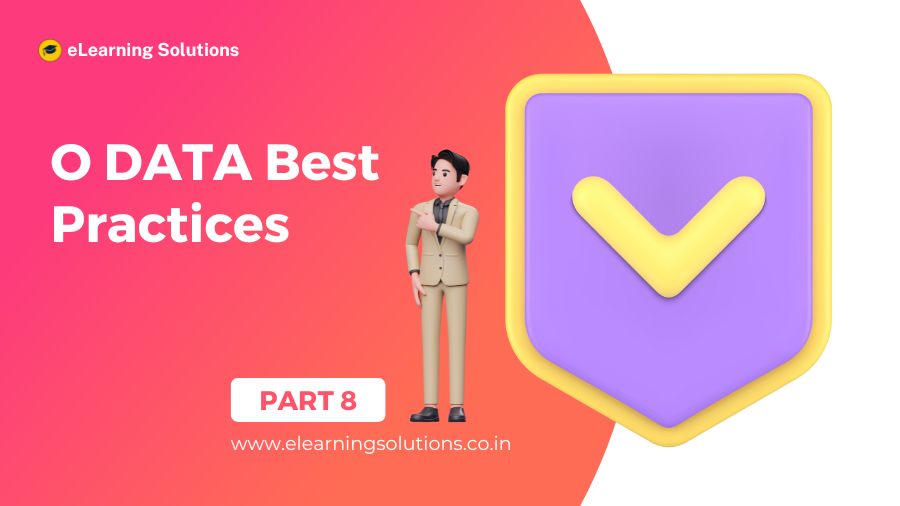O DATA, the Open Data Protocol, is a powerful and standardized way to build Web APIs that enable data exchange between clients and servers. To create efficient, scalable, and maintainable O DATA services, developers need to follow best practices. In this article, we will explore three essential aspects of O DATA best practices: Designing O DATA APIs, Performance and Optimization Techniques, and Error Handling and Exception Management.

Designing a well-structured and user-friendly O DATA API is crucial for its success and adoption. A well-designed API allows clients to interact seamlessly with the data and facilitates the smooth flow of information between the server and the consumers. Here are some best practices for designing O DATA APIs:
Identifying Resources and Entity Sets
Before building an O DATA API, it’s important to identify the resources and entity sets that the API will expose. Resources represent the data entities, and entity sets group similar resources together. This organization ensures that clients can easily query and manipulate related data.
Proper Use of HTTP Methods
O DATA APIs should adhere to RESTful principles, and developers should make proper use of HTTP methods. Use GET to retrieve data, POST to create new resources, PUT to update existing resources, and DELETE to remove resources. Properly using HTTP methods ensures that API operations are intuitive and predictable.
Data Modeling and Entity Design
Design meaningful entity types that are self-descriptive and easy to understand. Utilize descriptive field names and avoid ambiguous terminology. Establish relationships and associations between related entities to enable efficient data retrieval and manipulation.
2. Performance and Optimization Techniques

Performance optimization is critical for delivering fast and responsive O DATA services. Optimizing the API’s performance enhances the user experience and reduces the load on the server. Here are some essential performance and optimization techniques for O DATA APIs:
Caching and Data Prefetching
Implement caching mechanisms to store frequently requested data in memory. Caching reduces the need for repeated server requests and improves response times. Data prefetching retrieves related data in advance, anticipating client needs and reducing the number of round trips to the server.
Reducing Network Payloads
Minimize the size of data payloads returned by the API to reduce network bandwidth usage. Using compression techniques like Gzip can significantly reduce the payload size. Additionally, provide selective field projection to limit unnecessary data inclusion in responses.
Query Optimization
Leverage O DATA’s powerful query options, such as $filter, $orderby, $top, and $skip, to fine-tune data retrieval. Optimize queries to return only the data that clients need, avoiding overly complex and resource-intensive filters.
Batch Requests
O DATA allows batching multiple requests into a single HTTP request, reducing the overhead of individual requests. Batch requests enable clients to bundle multiple operations together and send them to the server as a single batch.
3. Error Handling and Exception Management

Proper error handling and exception management are crucial for the reliability and robustness of O DATA services. Effective error handling ensures that clients receive clear and meaningful error messages, which helps them understand and resolve issues. Here are some best practices for error handling and exception management:
Providing Clear and Meaningful Error Messages
When errors occur, provide clear and informative error messages that assist developers and users in understanding and resolving the issues. Include relevant information such as error codes, descriptions, and suggested actions.
Handling Exceptions Gracefully
Handle exceptions gracefully to avoid potential data leaks or system failures. When an unexpected situation arises, the API should respond with an appropriate HTTP status code, such as 404 Not Found or 500 Internal Server Error. Additionally, logging exceptions can help developers diagnose and troubleshoot issues.
Standardizing Error Responses
Consider standardizing error responses across the API to provide a consistent experience for clients. Use consistent error formats and status codes to make error handling more predictable for developers using the API.
Conclusion
Following best practices is essential for building high-quality and efficient O DATA APIs. By designing well-structured APIs, optimizing performance, and implementing effective error handling, developers can create O DATA services that are scalable, reliable, and user-friendly. Adopting these best practices ensures that O DATA services deliver exceptional performance and provide a seamless experience for clients.
FAQs (Frequently Asked Questions)
-
-
- Do O DATA best practices apply to all types of O DATA services? Yes, O DATA best practices are applicable to all types of O DATA services, regardless of their complexity or size.
-
- What is the significance of query optimization in O DATA APIs? Query optimization ensures that API requests are efficient and return only the necessary data, improving response times and reducing server load.
-
- Why is caching important in O DATA APIs? Caching reduces the need for repeated server requests by storing frequently requested data in memory, which improves response times and enhances overall performance.
Bonus: Courses For Sap Hana Training
PART-7
PART-9
Find Your Preferred Courses
SAP SD (Sales and Distribution) is a module in the SAP ERP (Enterprise Resource Planning) system that handles all aspects of sales and distribution processes. S4 HANA is the latest version of SAP’s ERP suite, built on the SAP HANA in-memory database platform. It provides real-time data processing capabilities, improved…
SAP Human Capital Management (SAP HCM) is an important module in SAP. It is also known as SAP Human Resource Management System (SAP HRMS) or SAP Human Resource (HR). SAP HR software allows you to automate record-keeping processes. It is an ideal framework for the HR department to take advantage…
I am text block. Click edit button to change this text. Lorem ipsum dolor sit amet, consectetur adipiscing elit. Ut elit tellus, luctus nec ullamcorper mattis, pulvinar dapibus leo.
Salesforce Developer Training Overview Salesforce Developer training advances your skills and knowledge in building custom applications on the Salesforce platform using the programming capabilities of Apex code and the Visualforce UI framework. It covers all the fundamentals of application development through real-time projects and utilizes cases to help you clear…
SAP EWM stands for Extended Warehouse Management. It is a best-of-breed WMS Warehouse Management System product offered by SAP. It was first released in 2007 as a part of SAP SCM meaning Supply Chain Management suite, but in subsequent releases, it was offered as a stand-alone product. The latest version…
Oracle PL-SQL is actually the number one database. The demand in market is growing equally with the value of the database. It has become necessary for the Oracle PL-SQL certification to get the right job. eLearning Solutions is one of the renowned institutes for Oracle PL-SQL in Pune. We believe…
Course details for Pega Training in Pune Elearning solution is the best PEGA training institute in Pune. PEGA is one of the Business Process Management tool (BPM), its development is based on Java and OOP concepts. The PAGA technology is mainly used to improve business purposes and cost reduction. PEGA…
SAP PP Training Institute in Pune SAP PP training (Production Planning) is one of the largest functional modules in SAP. This module mainly deals with the production process like capacity planning, Master production scheduling, Material requirement planning shop floor, etc. The PP module of SAP takes care of the Master…
SAP BASIS Module Course Content (1) Hardware and Software Introduction (i) Hardware (a) Hardware Introduction (b) Architecture of different Hardware devices (ii) Software (a) Software Introduction (b) Languages and Software Development (c) Introduction to OS (d) Types of OS (iii) Database Concepts (a) Introduction (b) Database Architecture and concepts (c)…
Curriculum Details SAP HANA Administration SAP HANA Introduction SAP HANA Introduction SAP HANA Information Sources Installation Preparation SAP HANA Sizing Linux Operating system requirements SAP HANA Installation Introduction to SAP HANA Lifecycle Management tools Describing Advanced Installation options Explaining a Distributed system SAP HANA Architecture SAP HANA Architecture and Technology…
Business Warehouse (BW) is SAP’s data warehousing application; it uses an SAP NetWeaver application server, but can run on many different databases. Improvements come with each version of Courses for sap BW on HANA training, but a really big jump in functionality comes when SAP BW is installed on the…
SAP SAP HANA simple logistics is also known as HANA enterprise management. Different area of business is combined in this suit itself like HANA enterprise-management helps in faster and efficient processing of business data in the area of logistics, supply chain, procurement, user experience, sales, partner management. So Course for…
ABAP remains a key language as many SAP business applications and custom developments are written in ABAP, with Courses for sap ABAP on HANA training there are numerous improvements. The ABAP language, which allows writing streamlined ABAP code and benefit from SAP HANA. SAP HANA is a relational DBMS in SAP…
SAP HANA is the latest ERP Solution from SAP, which is a combination of Hardware and Software. HANA has unprecedented adoption by the SAP customers. courses for SAP HANA training institutes. SAP HANA is the latest, in-memory database, and platform which can be deployed on-premises or cloud. SAP HANA is a…
Oracle Applications R12 HRMS is one of the most demanded applications by most organizations. It is the core application possess by the ERP system. The core objective of the organization to implement Oracle R12 HRMS is to organize the entire activates of human resources management. An Elearning solution is well…
Elearning solutions provide training suit for Oracle Apps R12 SCM with training from industry experts. The organizations are adopting Oracle’s supply chain management cloud as they deliver the insights, visibility, and capabilities for organizations’ management. Oracle Apps R12 SCM allows the industry to create own intelligent supply chain. Hence, it…
Oracle Apps R12 Technical Course Elearning solutions is the best Oracle Apps R12 technical course in Pune owned by well trained and certified trainers. The training is conducted by the best experienced IT professionals with skilled resources. The course structure is based on the real-time scenario so that it will…

₹25,000.00
Elearning solutions is the best SAP FICO training institute in Pune. SAP FICO is the Finance and Cost controlling module is one of the most important and widely used SAP ERP modules among organizations. As it is very robust and encounter almost all the business processes. In SAP FICO, FI…
Elearning solutions provide SAP SD training. The tutorials are designed for the students who desired to understand SAP SD concepts and implement them in practice. The SAP SD training is delivered by industry experts, who are aware of the real-time scenarios. Hence, supporting students understand, what will be there on…
SAP WM training is offered by Elearning solutions provides 100% hands-on practical classes. The primary focus of training is getting placement for all the students. The tutorials are designed for the students who wished to work on live projects for the organizations. The syllabus of SAP WM training is crafted…
Elearning solutions are the best SAP MM training institute in Pune. SAP MM (material management system) is one of the important models of the SAP ERP system, which is particularly designed for business processes. SAP MM deals with the entire material and inventory management of the organization. The module is…
Elearning Solutions best SAP ABAP training institute in Pune provides real-time training for students. SAP ABAP (Advanced Business Application Programming) is a programming language for building SAP applications such as SAP R/3 which runs in the SAP ABAP runtime environment. (SAP ABAP online course) SAP ABAP is used by organizations…







 WhatsApp us
WhatsApp us